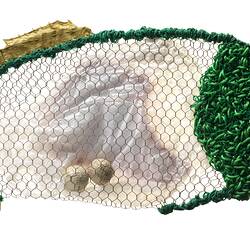Summary
Sculpture of Murray Cod made from recycled materials. The structure comprises chicken wire with the features of the fish (mouth, face, silhouette and tail) infilled (woven) with green nylon rope and twine, the mouth is accentuated with woven yellow twine. The top fins comprise sharpened wooden pegs encased in coated paper to represent both fish spines and fins. Bottom fins also comprise coated paper attachments. Two painted gum nuts are attached as eyes to the obverse and reverse sides of the sculpture. Further, enclosed in the belly of the fish are a white plastic bag and two golf balls on one side and a plastic coated paper element has been attached to the other side with pink synthetic twine. The paper element possibly depicts an aerial view of waterways.
Local Name
Mewurk or Goodoo
Physical Description
Sculpture of Murray Cod made from recycled materials. The structure comprises chicken wire with the features of the fish (mouth, face, silhouette and tail) infilled (woven) with green nylon rope and twine, the mouth is accentuated with woven yellow twine. The top fins comprise sharpened wooden pegs encased in coated paper to represent both fish spines and fins. Bottom fins also comprise coated paper attachments. Two painted gum nuts are attached as eyes to the obverse and reverse sides of the sculpture. Further, enclosed in the belly of the fish are a white plastic bag and two golf balls on one side and a plastic coated paper element has been attached to the other side with pink synthetic twine. The paper element possibly depicts an aerial view of waterways.
Significance
Yorta Yorta artist Treahna Hamm shares her knowledge of Mewurk/ Goodoo (Murray cod) and the cultural significance of this fish and its habitat;
'To Aboriginal people, the Murray Cod is called 'old man of the river', as this species of fish has been known to live to be the length of a man (6ft) (1.8 metres) and to weigh around 250lb (113 kilograms). 'The Murray Cod's environment of Dhungala (Murray River) has been highlighted in the past several decades as being in declining health. In my lifetime I have experienced this. The water of the River used to be so clear that you could look down and see the trails, tracks and holes of insects and small creatures along the bank; now it is murky. The fish sculpture represents the decay of the river, with the use of wire and pollution found and incorporated into its body. The golf balls are swallowed by the cod, which they mistake for fish eggs, an interruption of their natural diet and also life threatening. On the side of the sculpture, a membrane which is found within the body of the Murray Cod is highlighted. The membrane is said to be an imprint of the trees the fish was born under. Like eels and salmon, the Cod's life journey starts here and ends when the fish returns to die under it. There has been an incredible impact on the Murray River in the past. Dhungala is the creation site of the Yorta Yorta people and one that needs to be respected the same as any church, temple, mosque or other place of worship. We must always remember that a church can be rebuilt at any time and in any place, Dhungala cannot. We all need to remember, too, that we should not pollute any creation site as we would not a church.' Treahna Hamm, 2013
More Information
-
Object/Medium
Craft piece
-
Maker
-
Cultural Groups
-
Locality
-
Date Produced
-
Fully Extended
870 mm (Length), 40 mm (Width), 335 mm (Height)
-
Classification
-
Date Made
-
Maker
-
Clan/Language Group
-
Place Made
-
Indigenous Region
-
Keywords
-
Type of item
-
Discipline
-
Category
-
Collecting Areas


